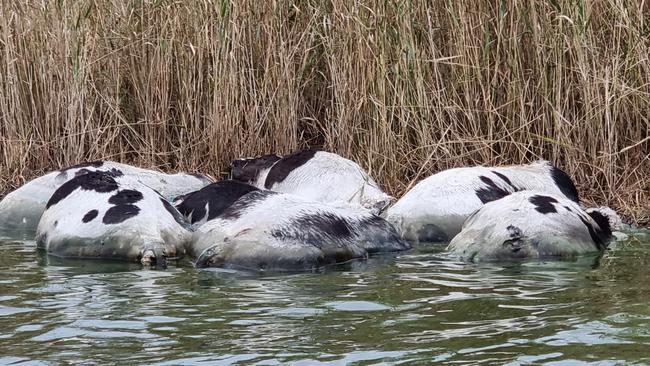River kill: Dead cattle and fish line the banks of the Curdies River
The rotting carcasses of at least 26 dairy cattle have been removed from the Lower Curdies River and their owner has been contacted.

Victoria
Don't miss out on the headlines from Victoria. Followed categories will be added to My News.
The rotting carcasses of at least 26 dairy cattle have been removed from the Lower Curdies River in the wake of a toxic blue-green algal outbreak.
The Department of Environment, Land, Water and Planning confirmed they had removed the cattle and contacted the owner over the weekend.
Just what killed the Holstein cattle and who owns them is yet to be determined, but their bloated bodies were found alongside thousands of dead brim, estuarine perch and even water birds.

DELWP issued a statement today that its staff and those from the EPA Victoria, Wannon Water and the Corangamite Catchment Management Authority were actively managing the ongoing toxic blue green algae bloom affecting the Peterborough Coastal Reserve and Curdies River.
“Blooms of BGA are common in waterways like this due to changes in water levels, nutrient inflows and temperature,” the a DELWP spokesman said.
“The bloom is expected to take some time to clear until there is significant rainfall and cooler temperatures.”
Wannon Water have tested the water to confirm toxic blue green algae is present and is the cause of the fish deaths.
“Wannon Water have confirmed that the bloom reported in the Curdies River is not connected to the Peterborough Sewage Treatment Plant,” the DELWP spokesman said.
“Wannon Water does not source water from the Curdies River as part of its supply system. As a requirement, Wannon Water routinely sample all recycled water, including prior to irrigation, and conduct regular site visits and inspections of their facilities to ensure structural integrity.”
But Victoria’s recreational anglers are angered that the EPA and Department of Environment, Land, Water and Planning bureaucrats have declared the algal outbreak a natural event, despite numerous reports calling for action on dairy farm nutrient run-off into the river.
VRFish Chair Rob Loats said the Curdies River, which was one of Victoria’s premier brim streams, had become an environmental disaster that EPA and DELWP seemed to be ignoring.
“The current handpassing of blame between State government agencies,
including the EPA, will not fix this issue,” Mr Loats said. “Nor will putting heads in the sand. This type of response is utterly unacceptable to Victoria’s recreational fishing community.
“We’re watching thousands of native fish go belly up and now dead cattle floating down the river. This is not a small, limited fish kill as stated by DELWP or a natural event as stated by the Corangamite Catchment Management Authority.”
“This is an unmitigated disaster, that was foreseen decades ago in risk assessments and
catchment strategies ever since.
“If taxpayer funded agencies cannot respond in an appropriate manner, then it’s time for the current Government to direct funding to agencies that can.
“The Victorian community deserves better than a premier fishing destination being turned into a drain with shrugged shoulders as the response.
“The Minister responsible for Energy, Environment and Climate Change Lily D’Ambrosio must intervene and give this issue due diligence. I can only suggest that instead of signing off on new parks that lock recreational fishers out of waterways, that the Minister direct her attention to this disastrous environmental issue that she has a legislative obligation to remedy, let alone prevent” Mr Loats said.

Local Chris Searle, who took a video of the dead cattle, said blue-green algal outbreaks had become more frequent and intense in recent years.
“DELWP has described it as only minor and localised, which is not correct,” Mr Searle said. “Many kilometres of river have been affected.
“Prior to this event I made a complaint to the EPA regarding the water quality in the system. The reply I received from them stated it would be fully investigated and prosecutions would be made.”
“I’ve since read in media reports that this will not be the case as it’s deemed to be a natural event.
“They would also have to prosecute every farmer on its banks and its tributaries and everyone knows that wouldn’t happen.
“While I don’t dispute that blue-green algae occurs naturally, I do believe that the frequency and the intensity of the outbreaks are due to poor farming practices.
“High rates of fertiliser and the practice of pumping out effluent ponds onto pasture is in my opinion leading to high levels of nutrients running into our waterways. Especially in times of high rainfall.”
“Ever increasing dairy herd sizes, livestock grazing on the banks of waterways and a lack of vegetation to act as filter that stop nutrients entering waterways are issues that need to be addressed.”
“Catchment Management Authorities and the EPA both say its one another’s issue with no one being accountable.”
“I sincerely hope that your organisation can lobby the relevant persons and achieve a favourable outcome for not just the Curdies but for all of our waterways.
“I believe the Curdies is Victoria’s biggest dairy sewer. Let’s start there.”
Numerous studies have been conducted into the Curdies River, with a 2008 study finding that aas far back as 2001 the EPA was warning “total nitrogen and phosphorous concentrations of the estuary have consistently exceeded state objectives”.
The studies have called for increased riparian fencing and vegetation, as well as effective management and monitoring of dairy effluent ponds and farm runoff.
Originally published as River kill: Dead cattle and fish line the banks of the Curdies River




